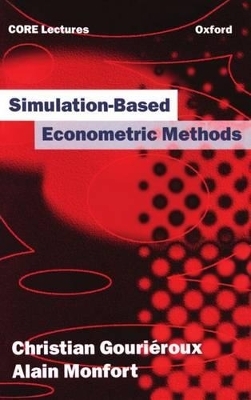
Simulation-based Econometric Methods
Seiten
1997
Oxford University Press (Verlag)
978-0-19-877475-4 (ISBN)
Oxford University Press (Verlag)
978-0-19-877475-4 (ISBN)
This book presents an exciting new set of econometric methods. They have been developed as a result of the increase in power and affordability of computers which allow simulations to be run. The authors have played a large role in developing the techniques.
This book introduces a new generation of statistical econometrics. After linear models leading to analytical expressions for estimators, and non-linear models using numerical optimization algorithms, the availability of high- speed computing has enabled econometricians to consider econometric models without simple analytical expressions. The previous difficulties presented by the presence of integrals of large dimensions in the probability density functions or in the moments can be circumvented by a simulation-based approach.
After a brief survey of classical parametric and semi-parametric non-linear estimation methods and a description of problems in which criterion functions contain integrals, the authors present a general form of the model where it is possible to simulate the observations. They then move to calibration problems and the simulated analogue of the method of moments, before considering simulated versions of maximum likelihood, pseudo-maximum likelihood, or non-linear least squares. The general principle of indirect inference is presented and is then applied to limited dependent variable models and to financial series.
This book introduces a new generation of statistical econometrics. After linear models leading to analytical expressions for estimators, and non-linear models using numerical optimization algorithms, the availability of high- speed computing has enabled econometricians to consider econometric models without simple analytical expressions. The previous difficulties presented by the presence of integrals of large dimensions in the probability density functions or in the moments can be circumvented by a simulation-based approach.
After a brief survey of classical parametric and semi-parametric non-linear estimation methods and a description of problems in which criterion functions contain integrals, the authors present a general form of the model where it is possible to simulate the observations. They then move to calibration problems and the simulated analogue of the method of moments, before considering simulated versions of maximum likelihood, pseudo-maximum likelihood, or non-linear least squares. The general principle of indirect inference is presented and is then applied to limited dependent variable models and to financial series.
1. Introduction and Motivations ; 2. The Method of Simulated Moments ; 3. Simulated Maximum Likelihood, Pseudo-maximum Likelihood, and Nonliner Least Squares Methods ; 4. Indirect Inference ; 5. Applications of Limited Dependent Variable Models ; 6. Applications to Financial Series ; 7. Applications to Switching Regime Models
| Erscheint lt. Verlag | 9.1.1997 |
|---|---|
| Reihe/Serie | OUP/CORE Lecture Series |
| Zusatzinfo | line figures, tables |
| Verlagsort | Oxford |
| Sprache | englisch |
| Maße | 160 x 241 mm |
| Gewicht | 479 g |
| Themenwelt | Mathematik / Informatik ► Mathematik ► Angewandte Mathematik |
| Wirtschaft ► Volkswirtschaftslehre ► Ökonometrie | |
| ISBN-10 | 0-19-877475-3 / 0198774753 |
| ISBN-13 | 978-0-19-877475-4 / 9780198774754 |
| Zustand | Neuware |
| Haben Sie eine Frage zum Produkt? |
Mehr entdecken
aus dem Bereich
aus dem Bereich
Buch | Softcover (2024)
Springer Vieweg (Verlag)
44,99 €
Anwendungen und Theorie von Funktionen, Distributionen und Tensoren
Buch | Softcover (2023)
De Gruyter Oldenbourg (Verlag)
69,95 €


